The best home audio systems boost your home entertainment experience by filling your spaces with rich and balanced sound. The best audio systems deliver exceptional sound quality because of their premium internal components, such as drivers, the crossover network, and the cabinet.

Below are the 12 best home audio systems you’ll find on the market in 2024.
- Klipsch The One Plus
- JBL Authentics 500
- Morel Högtalare
- IKEA SYMFONISK Bookshelf
- Sonos Era 300
- Pandoretta° 360° Sound System
- Klipsch The Three Plus
- Sonos Era 100
- Amazon Echo Studio
- Amazon Echo Gen 4
- Sonos Move 2
- Harman Kardon SoundSticks III Speakers
Which of these audio systems is most suitable for your home depends on your connectivity, portability, and integration preferences, as well as the rooms where you plan to use the speakers. Our guide below walks you through the features, advantages, and disadvantages of the 12 best audio systems, and gives advice on choosing the best one for your home.
1. Klipsch The One Plus
The Klipsch The One Plus is a table-top wireless speaker with a retro design and high-quality sound. The speaker’s best features are the rich, room-filling, dynamic audio and powerful bass it delivers despite its small size. This compact speaker features a stylish form and a classic, mid-century-inspired design. While the speaker is small, it’s not designed for on-the-go use as it’s wired and does not run on batteries.
View in gallery
The Klipsch The One Plus relies on Bluetooth connectivity to stream your music wirelessly. You’ll find that Bluetooth pairing is quick and easy with this speaker, while the Klipsch Connect App facilitates setup. The speaker lets you stream music from a variety of compatible devices, including smartphones, tablets, and computers.
Below are some of the main pros and cons to consider if you’re thinking about picking up a Klipsch The One Plus for your home stereo system.
Pros
- Excellent audio quality: The speaker produces clear and powerful audio despite its small size.
- Attractive retro design: The design of this speaker is visually appealing, with a minimalist, retro aesthetic that features real wood veneer.
- Easy setup and use: The speaker is user-friendly, and it takes little time and effort to pair it with a Bluetooth-compatible device.
Cons
- Not portable: The Klipsch The One Plus is hard-wired, so you cannot use it on the go.
Customer reviews for the Klipsch The One Plus are generally positive, and the speaker gets lots of praise for its sound quality and stylish design. The price is $249 in the United States.
2. JBL Authentics 500
The JBL Authentics 500 is a bookshelf-style wireless speaker that blends vintage looks with modern connectivity features. This speaker’s strongest feature is its balanced and detailed sound profile, which gives you a satisfying audio experience and has ample power to fill large rooms with sound. The Authentics 500 has a larger footprint than most portable speakers but retains a classic, attractive design. It’s relatively compact for a bookshelf speaker, but the lack of a battery means the Authentics 500 is meant for stationary use: it’s portable, but you can’t use it on the go.
View in gallery
The JBL Authentics 500 connects to your music sources wirelessly via Wi-Fi and Bluetooth. As long as you’re playing music on a WiFi or Bluetooth-enabled device, it will pair seamlessly with JBL Authentics 500. The setup process for the speakers is likewise straightforward.
The following are some key pros and cons to consider before purchasing the JBL Authentics 500.
Pros
- Immersive sound: The JBL Authentics 500 produces room-filling sound with a wide soundstage and satisfying bass response.
- Visually appealing design: The retro, yet unobtrusive aesthetic comprises an elegant, leather-like casing and tactile knobs.
- Flexible connection options: The Authentics 500 offers both Bluetooth and Wi-Fi connectivity, so you can pair this speaker with any modern device to stream audio.
Cons
- Limited portability: The Authentics 500 works on AC power, so it’s better suited as a stationary home speaker than a portable option.
- Potential Wi-Fi issues: Your home network’s strength and quality directly impacts the speaker’s performance.
- Price: The Authentics 500 sits at the higher end of the smart speaker market, so it’s not suitable for budget-focused buyers.
This speaker typically retails around the $1,000 mark in the US. Customer reviews for the JBL Authentics 500 are generally positive, as most users applaud its robust sound and elegant looks.
3. Morel Högtalare
The Morel Högtalare is a wireless speaker that produces high-resolution audio. Its best feature is its clear, detailed sound that delivers a rich and faithful representation of your music. Morel Högtalare’s room-filling sound and powerful bass are a pleasant surprise, since the unit is quite compact. You have flexible placement options with this compact speaker – you can mount it on the wall or place it on a shelf; in fact, it’s designed to fit neatly into IKEA’s Kallax shelving unit. That said, the unit is meant largely for stationary use, so it’s not a great option if you need a portable speaker.
View in gallery
The Högtalare connects to music output devices via Bluetooth, 3.5mm stereo plug, or through WiFi. To connect through WiFi, you must use Chromecast or a similar device – just plug it into the USB port at the back of the speaker, then connect to it as you normally do.
Consider the following pros and cons of the Morel Högtalare speaker before you purchase it.
Pros
- Exceptional sound quality: Morel Högtalare are renowned for their accurate and detailed sound reproduction, offering a natural and lifelike listening experience across a wide range of musical genres.
- Elegant design: The sleek, minimalist aesthetic effortlessly blends with any modern living space.
- High-quality build: Morel utilizes premium components and meticulous craftsmanship, ensuring longevity and lasting performance.
Cons
- Cost: As with many high-end speakers, Morel Högtalare come with a premium price tag.
- Room placement sensitivity: To achieve their full sonic potential, Morel Högtalare require careful placement and might be more demanding in terms of room acoustics than some other speaker options.
- Power requirements: These speakers often benefit from a dedicated high-quality amplifier to truly unlock their exceptional sound quality.
The Morel Högtalare retails for $400-$550 in the US, which is at the higher end of the price range. However, this price point is competitive when you compare it to similar audiophile-oriented wireless bookshelf speakers, such as the KEF LSX II ($1399) or Audioengine A5+ Wireless ($699). Moreover, the overwhelmingly positive customer reviews for the Morel Högtalare make it clear that this speaker offers excellent value for the money.
4. IKEA SYMFONISK Bookshelf
The IKEA SYMFONISK Bookshelf is a budget-friendly wireless speaker designed in collaboration with Sonos. This compact speaker’s best feature is its integration with the Sonos ecosystem, which gives you multi-room audio capabilities and intuitive app-based control. The SYMFONISK Bookshelf generates robust sound for its small size, while the compactness gives you various placement options. You can mount this speaker horizontally or vertically on a wall, tuck it beside a bookshelf, or place it on top of a table. That said, it’s not a speaker you can use on the go.
View in gallery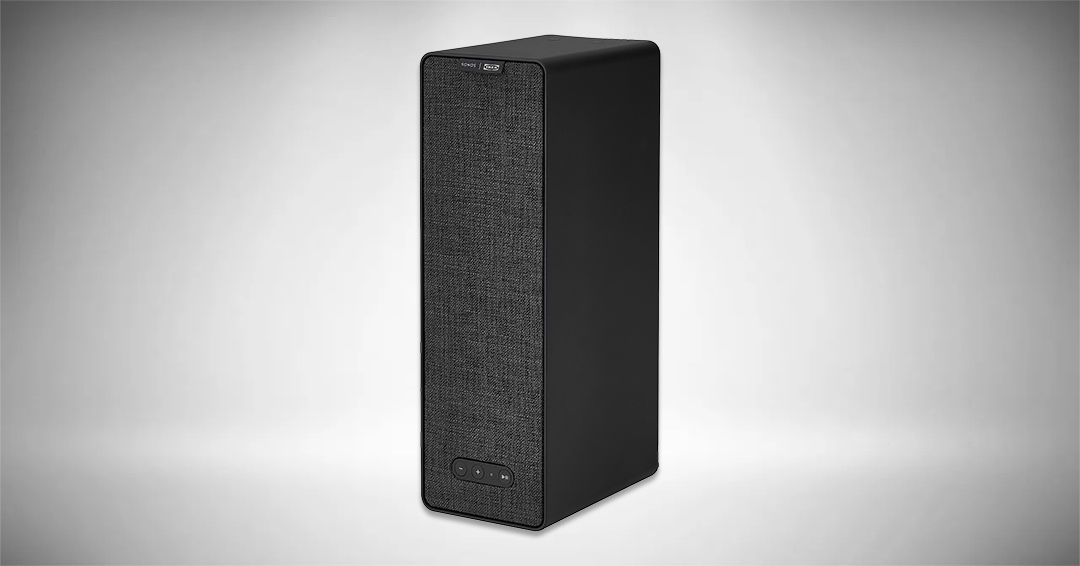
Connection options for the IKEA SYMFONISK Bookshelf include Wi-Fi and an Ethernet port for reliable streaming. Moreover, the speaker integrates with the Sonos app, which lets you set up the device, control audio in different rooms, and access various streaming services. You can even configure the speaker to work with virtual assistants like Alexa or Google Assistant.
Below is a summary of the pros and cons of the IKEA SYMFONISK Bookshelf.
Pros
- Versatile design: The IKEA SYMFONISK Bookshelf speaker seamlessly blends into any space. It can function as a standard bookshelf speaker, be discreetly tucked away, or be wall-mounted for enhanced versatility.
- Sonos integration: As part of the Sonos ecosystem, the SYMFONISK Bookshelf offers easy multi-room audio integration, advanced control options through the Sonos app, and access to numerous streaming services.
- Affordability: The SYMFONISK Bookshelf delivers respectable sound quality while remaining one of the most affordable entry points into the Sonos ecosystem.
Cons
- Sound limitations: While offering decent audio performance, the SYMFONISK Bookshelf lacks the depth and detail of higher-end speakers, particularly in the bass frequencies.
- Setup requires Sonos app: The speaker relies on the Sonos app for setup and control, which might be slightly less intuitive for those unfamiliar with the Sonos system.
- Limited standalone features: As a primarily Sonos-focused speaker, the SYMFONISK Bookshelf lacks features like Bluetooth connectivity or a dedicated 3.5mm input for use without integration into the Sonos network.
The IKEA SYMFONISK Bookshelf speaker typically retails for around $119 USD, and this price makes it one of the most affordable ways to enter the Sonos ecosystem. Customer reviews are generally positive, with praise for its value, integration with Sonos, and the compact, versatile design.
5. Sonos Era 300
The Sonos Era 300 is a smart speaker with spatial audio capabilities that deliver an immersive listening experience. Sonos uses advanced Dolby Atmos technology with six drivers to create a surround sound effect.
View in gallery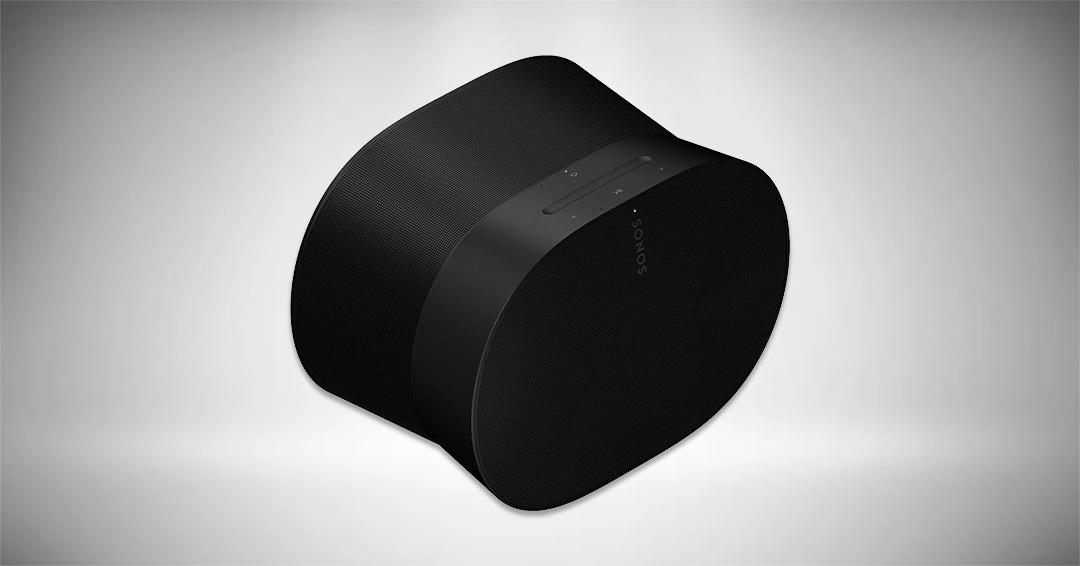
This model integrates seamlessly with the Sonos ecosystem and lets you pair it with other Sonos speakers for a comprehensive home theater setup. You can control the speaker via the Sonos app, or via voice commands and touch controls directly on the speaker itself.
The speaker comes in black and white color options and offers flexible placement – you can mount it on a stand or place it on a shelf.
Here’s a breakdown of the pros and cons of this Sonos speaker:
Pros
- Immersive sound: The Sonos Era 300 delivers high-quality sound. It supports spatial audio and relies on Dolby Atmos technology to deliver a captivating listening experience.
- Sleek design: The speaker’s design blends into modern home aesthetics and offers a contemporary, minimalistic look.
- Sonos ecosystem: Integration with the Sonos system gives you easy multi-room audio control, robust streaming service support, and versatile expansion options for your home audio setup.
- Automatic room tuning: The built-in Trueplay feature analyzes your room’s acoustic properties and optimizes sound output.
Cons
- High price: The Sonos Era 300 is priced amongst the upper tier of smart speakers, which is out of reach for budget buyers.
Prices vary depending on the retailer, but the Sonos Era 300 generally costs $360-$460 in the US.
Customer reviews of the Era 300 are overwhelmingly positive. Users praise the immersive sound quality, the ease of use with the Sonos app, and the speaker’s design. However, some reviewers mention that the speaker is less compact than its Sonos peers.
6. Pandoretta° 360° Sound System
The Pandoretta° 360° Sound System is a high-end wireless speaker that boasts a luxurious aesthetic (crafted by award-winning designer Thomas Feichtner) and is made with high-quality materials. The speaker’s best feature is its 360-degree sound projection, which delivers room-filling audio. The speaker easily connects to your devices via Bluetooth, WiFi, or a 3.5mm plug.
View in gallery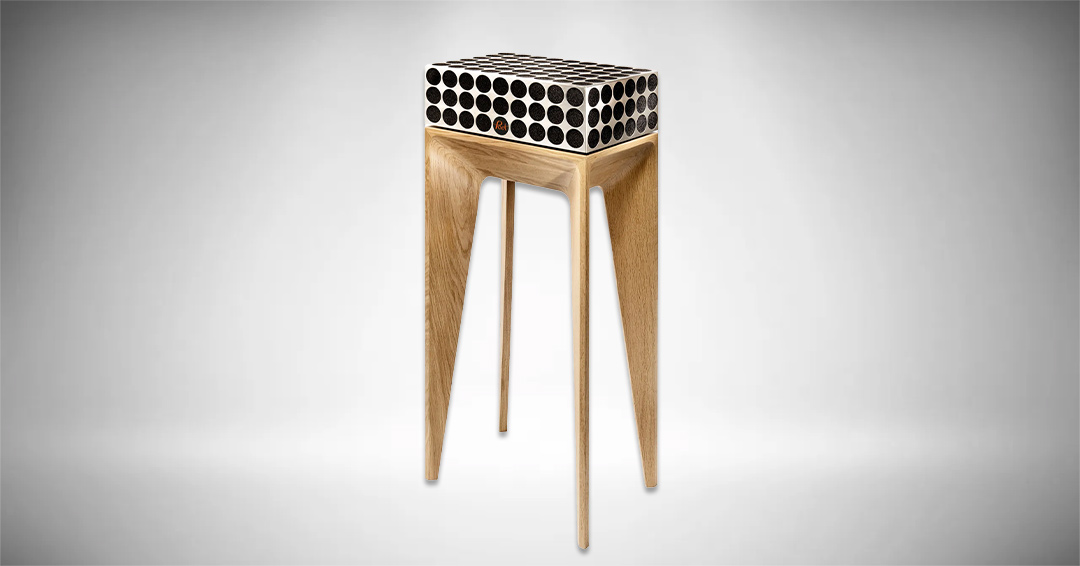
The Pandoretta° 360° Sound System affords an entirely automated user experience. The system automatically wakes up, adjusts its behavior based on input sources, and enters standby mode when you don’t use it. This automation eliminates your need for complex apps or settings to control the speaker.
Below is a breakdown of the pros and cons of the pandoretta° 360°.
Pros
- 360° sound: The Pandoretta° radiates sound evenly in all directions, which creates an optimal audio experience for everyone in a room.
- Striking design: The speaker features a visually captivating design that easily becomes a centerpiece in your space.
- High-fidelity components: Pandoretta° utilizes premium drivers and components to ensure excellent sound quality.
Cons
- High cost: The Pandoretta° comes at a significant price point of $3,800, which makes it all but unaffordable for the majority of audiophiles.
- Potential for overkill: For smaller rooms or solely casual listening, the unique 360° design is more than necessary and cost-prohibitive.
- Size and weight: The pandoretta° isn’t as compact or lightweight as smaller Bluetooth speakers, so its portability is limited.
The pandoretta° 360° is a niche, luxury product with an astronomical price point of $3,800. Given the exclusivity of this speaker, consumer reviews are hard to come by.
7. Klipsch The Three Plus
The Klipsch The Three Plus is a tabletop wireless speaker with a retro design and high-quality audio reproduction. Its best features are its rich, dynamic sound with powerful bass and its elegant retro aesthetic. Despite its compact form, this speaker is meant for stationary use as it requires AC power.
View in gallery
The Klipsch The Three Plus comes with physical controls on the speaker itself for volume, source switching, and basic playback functions. Connection options include Bluetooth, auxiliary input, and even a phono preamp for directly connecting a turntable. That said, this speaker doesn’t have Wi-Fi streaming or smart speaker functionality.
Below is a summary of the pros and cons of the Klipsch The Three Plus speaker.
Pros
- Superb audio quality: The Klipsch The Three Plus delivers a precise and dynamic sound. It excels at reproducing various musical genres with power and clarity.
- Retro design: The speaker features a visually appealing retro design that embodies both classic aesthetics and modern functionality.
- Versatile connectivity: The Three Plus offers multiple ways to connect your music sources. These include Bluetooth, USB-C, a 3.5mm input, and a phono preamp for directly connecting a turntable.
Cons
- Limited portability: Due to its need for AC power, the Klipsch Three Plus is not suitable for on-the-go use.
- No built-in voice assistant: It works with external voice-controlled devices, but lacks a built-in smart assistant.
The Klipsch The Three Plus typically retails between $320-$450 USD – a price point that places it at the higher end of the range. Most consumer reviews of the speaker are favorable, with the sound quality and robust build getting particular praise.
8. Sonos Era 100
The Sonos Era 100 is a smart speaker that offers powerful audio and advanced features for home entertainment. Its best features include integration with the Sonos ecosystem for multi-room sound, built-in voice control, and support for popular streaming services.
View in gallery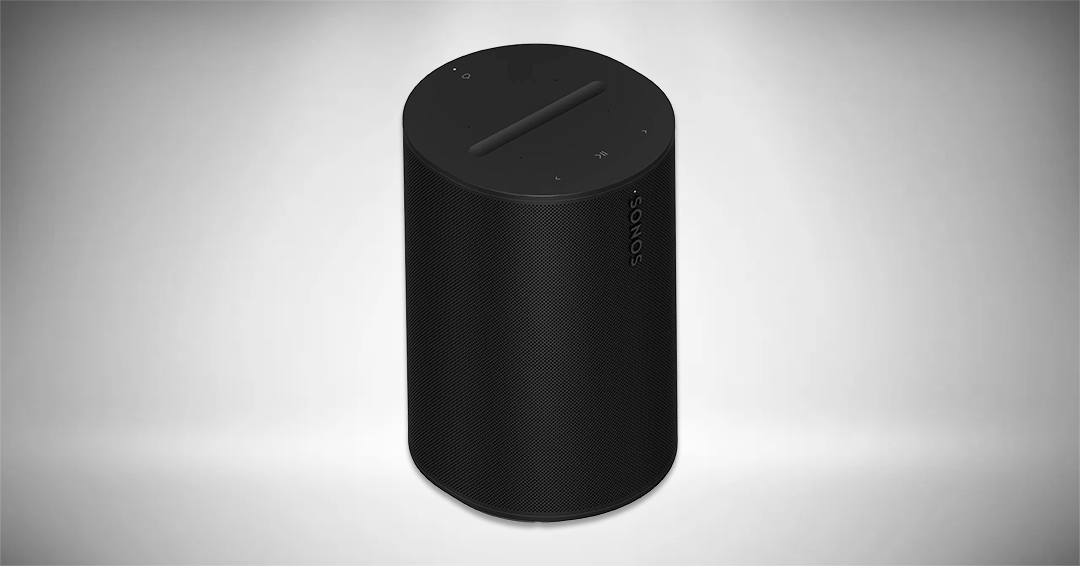
The Era 100 offers connectivity via Wi-Fi, Bluetooth, and the Sonos Line-In Adapter. The Era 100 works with the user-friendly Sonos app for setup, control, and integration with other Sonos products, while also supporting Alexa and Google Assistant.
This speaker is designed for versatile placement throughout your home, and you can mount in on the wall (wall mount is sold separately). Although you can easily move this speaker around your home, it requires AC power and is thus unsuitable for use on the go.
Pros
- Immersive sound: The Sonos Era 100 produces room-filling sound and delivers an impactful listening experience despite being compact.
- Sonos ecosystem integration: The Era 100 offers seamless integration with existing Sonos systems, easy control through the Sonos app, and supports numerous streaming services.
- Potential for Stereo Pairing: You can pair Era 100 with a second unit for a stereo setup.
- Affordability: The Era 100 is a more attainable entry point into the Sonos ecosystem compared to the brand’s premium offerings.
Cons
- Bass limitations: Due to its small size, the Era 100 does not produce the same deep, room-shaking bass as its larger Sonos counterparts.
- Reliance on the Sonos System: The speaker might be less appealing to those who don’t utilize Sonos products or streaming services.
Sonos Era 100 costs $320 in the US at the time of writing. This price point is on the higher end of the range, but affordable compared to other Sonos speakers. Consumers are generally thrilled with the speaker’s sound quality and integration with virtual assistants like Alexa.
9. Amazon Echo Studio
The Amazon Echo Studio is a smart speaker that produces immersive audio experiences with 3D formats like Dolby Atmos and Sony 360 Reality Audio. Its best features are the 3D sound capabilities and its comprehensive integration with Alexa, Amazon’s voice assistant.
View in gallery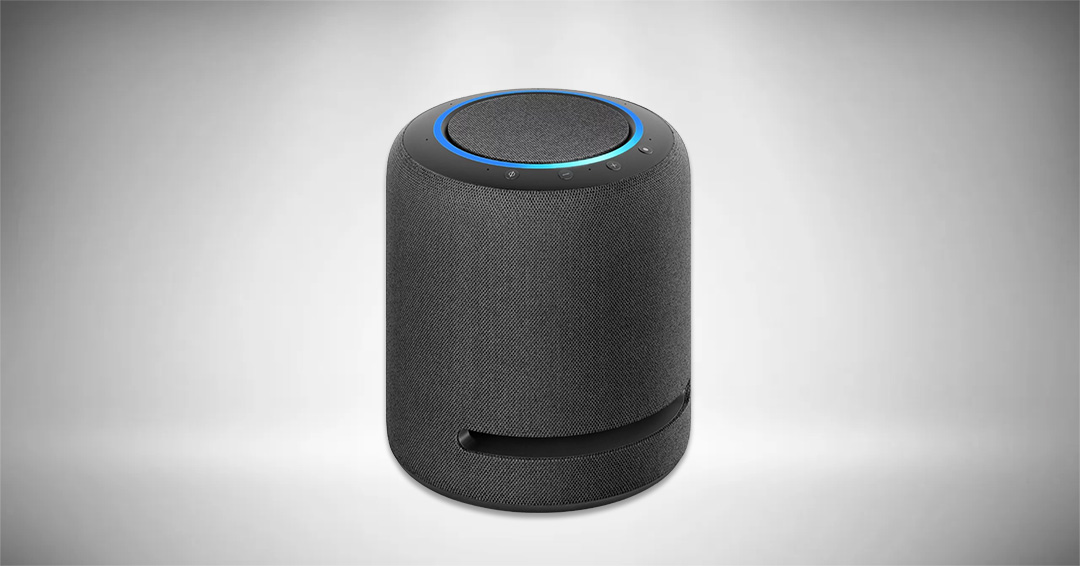
The speaker relies primarily on Amazon Alexa for voice control of music playback and smart home integrations. The Alexa app provides further settings and options for customization. Connection options for the Echo Studio include Wi-Fi, Bluetooth, and an auxiliary input. It’s designed to be a stationary speaker, but the compact size gives you some placement flexibility.
The following is a summary of the pros and cons of Amazon Echo Studio.
Pros
- Innovative 3D Audio: The Amazon Echo Studio offers a unique, immersive listening experience with Dolby Atmos and Sony 360 Reality Audio support, simulating a multi-speaker setup.
- Powerful Sound: The Echo Studio boasts impressive volume output and surprisingly strong bass for a smart speaker.
- Smart Home Hub: With built-in Alexa and Zigbee support, the Echo Studio can seamlessly control compatible smart home devices.
- Adaptive Room Tuning: The Echo Studio can automatically optimize its sound output to match the acoustics of your room.
Cons
- Audiophile Limitations: While offering excellent sound for a smart speaker, the Echo Studio might not satisfy the discerning ears of true audiophiles when compared to dedicated Hi-Fi systems.
- Size and Design: The Echo Studio has a bulky design compared to other Echo smart speakers, which might not be visually appealing to everyone.
- Alexa Reliance: Some features and functionality are heavily dependent on the Alexa ecosystem, potentially limiting users who prefer alternative voice assistants or streaming services.
The Amazon Echo Studio is a relatively affordable option within the smart speaker market, with a typical US retail price of $200. The speaker receives mostly positive reviews, with notable praise for its 3D audio capabilities and Alexa integration. However, some users find the sound quality less refined than in dedicated audio systems.
10. Amazon Echo Gen 4
The Amazon Echo Gen 4 is a smart speaker with versatile voice-control capabilities powered by Amazon Alexa. Its best features are the wide, Alexa-driven smart home control options and improved audio quality compared to prior Echo generations. The superior audio stems from the speaker’s woofer and two tweeters, which allow detailed sound reproduction.
View in gallery
The Echo Gen 4 relies primarily on Wi-Fi for streaming and smart features but supports Bluetooth for additional flexibility. The Alexa app allows for customization and management of smart home routines. Meanwhile, a built-in Zigbee hub lets you directly control compatible smart home devices.
The speaker is designed for stationary use, as it’s meant to coexist with your smart home ecosystem. That said, its integrated battery lasts up to 5 hours, so you can occasionally use the speaker on the go, too.
The following are the pros and cons of the Echo Gen 4:
Pros
- High audio quality: The Echo Gen 4 sounds significantly better than previous Echo generations. The vocals are clearer, and the soundstage is more balanced.
- Smart home hub: The built-in Zigbee hub allows direct control of compatible smart home devices.
- Alexa routines and skills: The Echo Gen 4 lets you access a wide array of Alexa skills and the ability to automate tasks via custom routines.
- Appealing design: The spherical shape is visually pleasing and blends well into most home interiors.
Cons
- Limited bass response: The Echo Gen 4 lacks the deep, powerful bass some users need for specific music genres.
- Alexa ecosystem: Many of the Echo Gen 4’s features rely heavily on Amazon services and integrations, which limits your options if you prefer other ecosystems.
The Amazon Echo Gen 4 costs around $99 in the US. This price point makes it a mid-range smart speaker option. The Amazon Echo Gen 4 gets mostly positive reviews for its improved sound quality and Alexa’s functionality. That said, some users are left wishing for richer audio.
11. Sonos Move 2
The Sonos Move 2 is a durable speaker designed to produce high-quality sound indoors and outdoors. Its best features are the new dual-tweeter design for a wider soundstage and the impressive 24-hour battery life. Meanwhile, the IP56 rating for dust and water resistance makes this speaker appealing for outdoor use. And though it’s larger than typical Bluetooth speakers, the Move 2 includes a built-in handle for easy portability.
View in gallery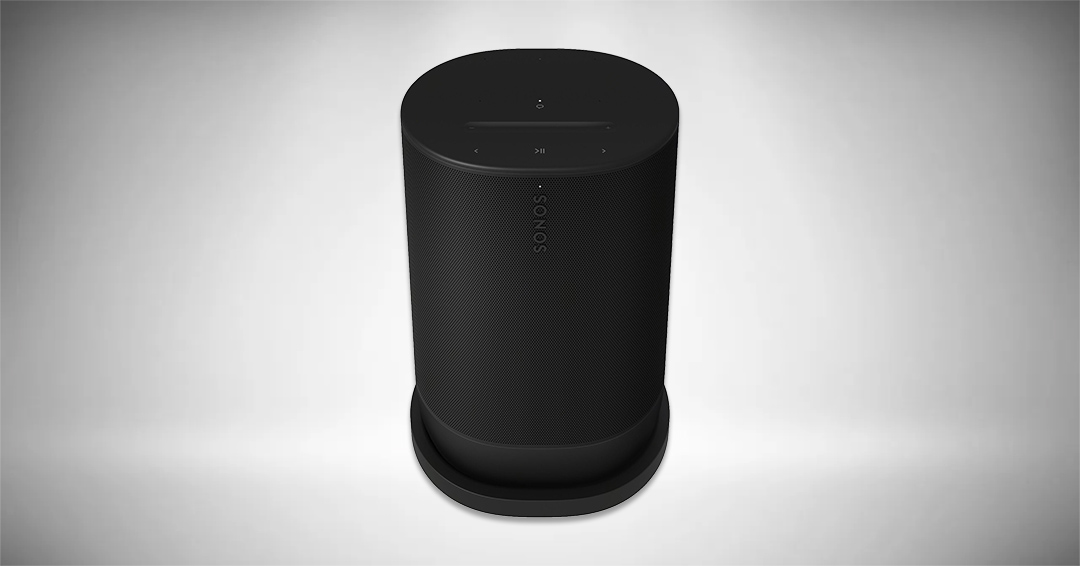
The Move 2 connects through both Wi-Fi and Bluetooth and works with nearly every popular streaming service. The speaker integrates voice control via Amazon Alexa and Google Assistant. Sonos Move 2 even uses Auto Trueplay to automatically optimize the sound for any environment.
Below is a summary of the Sonos Move 2 pros and cons.
Pros
- Exceptional sound quality: The Sonos Move 2 builds on the reputable sound signature of the original to deliver powerful, detailed, and balanced audio.
- Rugged design: The IP67 rating ensures the speaker withstands the elements, which makes it suitable for both indoor and outdoor use.
- Improved battery life: The Move 2 offers an impressive 24-hour battery life, which exceeds the original’s capabilities and gives you greater peace of mind.
- Sonos integration: The Move 2 expands your Sonos system and enables easy control with the Sonos app, multi-room possibilities, and access to streaming platforms.
- Bluetooth and WiFi connectivity: The speaker lets you switch between Bluetooth streaming on the go and WiFi for ideal audio quality and Sonos ecosystem features at home.
Cons
- Premium price: The Sonos Move 2 is a high-end speaker with a high price tag.
The Move 2 costs between $360-$450 in the US. The speaker remains highly rated overall, with its sound quality, durability, and versatility getting consistent praise. That said, some customers express minor concerns about Wi-Fi connectivity issues and a less-than-powerful bass response.
12. Harmon Kardon SoundSticks III Speakers
The Harmon Kardon SoundSticks III Speakers are an instantly recognizable speaker set thanks to their distinctive transparent design. Their most striking feature is this unique aesthetic, which makes them as much a visual statement as an audio system. The audio itself is of high quality, producing clear sound with a down-firing subwoofer for a deep, rich bass.
View in gallery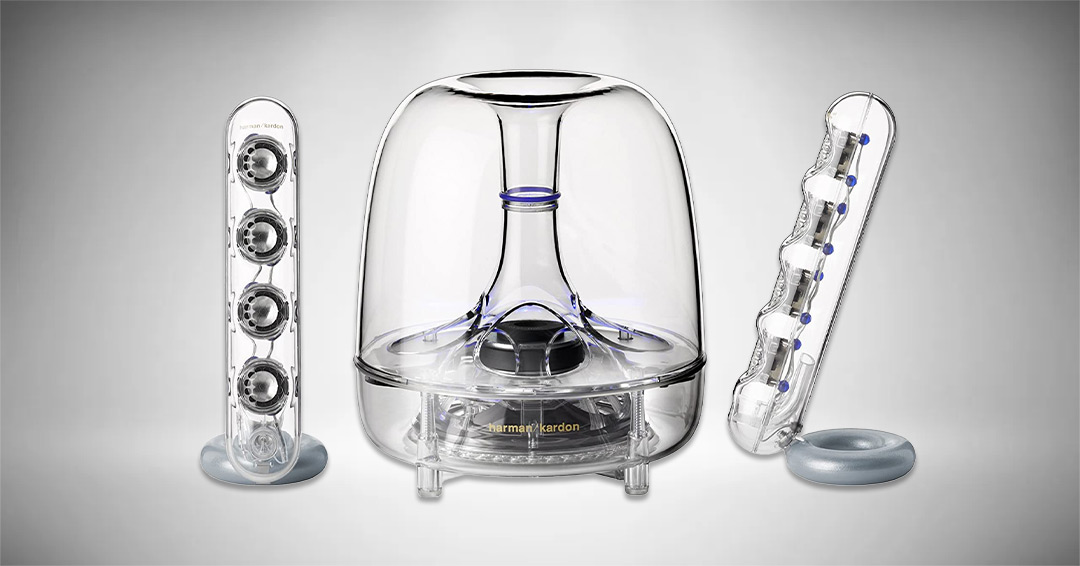
The SoundSticks III connects through a standard 3.5mm audio input and offers Bluetooth capability. Meanwhile, touch-sensitive volume controls on the right satellite speaker give you a touch of modern convenience.
The Harman Kardon SoundSticks III are designed for desktop or shelf placement and aren’t meant for on-the-go use since they work off AC power.
Consider the following pros and cons of the Harman Kardon SoundSticks III before you purchase this unit:
Pros
- Innovative design: The Harman Kardon SoundSticks III’s trendy transparent design is a unique selling feature, especially if you prefer industrial decor.
- Quality sound: The speaker set produces clear sound with a rich bass response.
- Easy setup and controls: The speakers are user-friendly thanks to their plug-and-play nature and convenient touch volume controls.
- Bluetooth capability: Bluetooth connectivity gives you the flexibility to connect different audio sources.
Cons
- Polarizing aesthetics: The unusual design of the SoundSticks III might not appeal to everyone’s taste.
- Non-standard connections: The primary wired connection is a 3.5mm jack, which may require adapters for some devices.
The Harman Kardon SoundSticks III sits in the middle of the price range, with a US price of $200-300. Consumer reviews are consistently positive, with most reviewers praising both the design and audio performance. That said, some users have found the bass to be a bit overpowering at higher volumes.
What is the most important feature of a home sound system?
Accurate and detailed sound reproduction is the most important feature of a home sound system. It’s the quality sound that transports you from your living room to the heart of a live performance or into the recording studio.
Four factors should work in harmony for a home sound system to deliver quality audio.
- High-quality drivers are essential. Drivers convert electrical signals into sound waves. For accurate reproduction, they must be made from robust materials that move precisely across the entire frequency spectrum. Their accurate movement ensures that every subtle note gets recreated faithfully.
- The speaker must have a quality crossover network. This network distributes the incoming audio signal to the appropriate drivers. A well-designed crossover ensures smooth transitions between the different frequency ranges handled by the woofer (bass), midrange driver (vocals, instruments), and tweeter (high frequencies). Without this seamless handoff, the sound becomes disjointed and unnatural.
- The speaker’s cabinet should be sturdy and inert, so that it doesn’t resonate with the sound waves coming from the drivers. Unwanted cabinet resonances color the sound and distort the audio signal. High-quality speaker cabinets are usually made from dense materials like MDF (medium-density fiberboard) and reinforced heavily to minimize vibrations.
- The positioning of the speakers in your home significantly impacts the perceived detail. Improper placement leads to reflections and cancellations that muddy the sound and obscure sonic details. So, take the time to position your speakers for optimal stereo imaging.
Why should you buy a good audio system for your home?
You should buy a good audio system for your home to get a clear sound reproduction that’s properly balanced.
A quality home audio system brings music to life with rich detail and clarity. It reveals nuances in your favorite songs and allows you to hear every word and sound effect in movies. If you’re a gamer, a good audio system immerses you into the heart of the action in your virtual world.
Moreover, a quality audio system delivers a balanced sound. Powerful bass frequencies create excitement without becoming muddy or overwhelming, while crisp highs shimmer without being harsh. This balanced presentation lets you enjoy long listening sessions without getting tired.
Do great home speakers cost a lot of money?
Yes, great home speakers cost a lot of money because they’re built with quality materials, their development demands extensive research, and their finishes are often of a high grade.
Good sound quality requires meticulous engineering and top-notch components. High-performance drivers, precision-tuned crossovers, and acoustically optimized cabinets are all made with precision and premium materials. These components naturally come with a higher cost compared to the basic drivers and simple construction you’d find in budget speakers.
The research and development that goes into designing great speakers takes time and money. Reputable manufacturers invest heavily in perfecting the sonic characteristics of their products to deliver accuracy and detail in their audio.
Moreover, premium speaker brands often use high-grade finishes and materials to make their speakers visually appealing. These premium finishes and durable materials play a major role in driving up the speakers’ price tag.
Can electric guitars be plugged into the home audio system?
Yes, you can plug an electric guitar into a home audio system, but it’s not recommended for three reasons.
Firstly, electric guitars output a weak, unprocessed signal, while home audio systems are designed to amplify the stronger line-level signals. This mismatch results in a thin, unsatisfying sound that lacks the punch associated with electric guitars. Secondly, electric guitar pickups send occasional high-voltage spikes. Most home audio systems withstand these, but they’re a risk factor for delicate, vintage equipment. Finally, home audio systems are designed for accurate and balanced reproduction across the entire frequency spectrum.
Electric guitars occupy a narrower band of frequencies and need specialized EQ settings for optimal tone. A home audio system can’t provide the tonal shaping needed for a good electric guitar sound.
What are the benefits of a premium speaker for your home?
Below are the five benefits of getting a premium speaker for your home.
- Superior audio quality: High-end speakers use meticulously engineered drivers, precision-tuned crossovers, and acoustically optimized cabinets to produce quality sound. Quality sound reproduction lets you enjoy music with detail, clarity, and a wide soundstage.
- Enhanced durability: Premium speakers are built with high-quality components, which ensure the longevity and reliability of the product.
- Aesthetics: Premium speakers generally come with elegant designs and premium finishes. They complement your decor and become a statement piece in your home.
- Advanced features: Top-of-the-line speakers often include technologies like room correction software or multi-room connectivity. These features help improve your home entertainment experience.
- Prestige: Owning a premium speaker symbolizes an appreciation for high-fidelity sound and a discerning taste in audio equipment for audiophiles.
What are the limitations of a premium home speaker?
Below are the four limitations of a premium home speaker.
- Cost: The superior sound quality and craftsmanship of premium speakers come at a significant price tag, so they’re often a substantial investment.
- Space requirements: High-performance speakers often have a large footprint that demands dedicated stands and careful placement for optimal sound.
- Complexity: Some premium speakers have complex setup procedures or advanced features that entail a learning curve on your part.
- Overkill for casual listening: If your primary use case is background music or casual listening, a premium speaker system is more than you need.
Which is the best speaker for the living room?
The Sonos Era 300 is an excellent choice for a living room speaker, as it offers exceptional sound quality, spatial audio with Dolby Atmos compatibility, seamless integration with the Sonos ecosystem, and a stylish design. However, what the “best” speaker is often varies from person to person, and depends on the following four factors:
- Room size: The power of the speaker should match the size of your space. A large living room requires a speaker system that adequately fills the area, while in a smaller room, a powerful speaker might be overwhelming.
- Sonic preferences: Speakers have varying sonic signatures that cater to different listening preferences. Some speakers prioritize deep bass, some focus on crisp and clear vocals, and some produce a balanced sound.
- Budget: Premium speakers offer superior sound quality, but come at a premium price. There are excellent options at various price points, so setting a budget helps you narrow down the choices.
- Aesthetics: Consider how the speakers complement the existing décor of your living room.
Which is the best Bluetooth home speaker?
The JBL Flip 6 is a strong contender for the title of best Bluetooth home speaker. It delivers a well-balanced sound profile with a powerful bass, comes with a rugged, waterproof design, and affords a long battery life. This combination of portability, durability, and sound quality makes the JBL Flip 6 a great all-around choice if you seek a versatile Bluetooth speaker.
However, what the “best” Bluetooth speaker is varies depending on your needs and priorities. Consider the following four factors when choosing your Bluetooth speaker:
- Sound quality: Decide whether you prefer balanced audio, powerful bass, or crisp highs, as different Bluetooth speakers satisfy different preferences.
- Portability: Determine whether you need an ultra-compact speaker or one that offers more powerful sound but has a slightly larger footprint.
- Additional features: Consider if features such as waterproofing, dustproofing, or smart assistant integration are necessary for your use case.
Which is the best kitchen speaker?
The Sonos Roam is an excellent choice for a kitchen speaker because of its compact, durable design that resists humidity and spills. Its seamless integration within the Sonos ecosystem, smart assistant compatibility, and long battery life add to the convenience of using this speaker in a kitchen. However, the ideal kitchen speaker may be different for everyone, depending on the four factors below.
- Size and placement: Kitchens often have limited counter space, so consider the speaker’s footprint when you choose the model.
- Smart features: Decide whether commands for controlling music and setting timers are important to you in your speaker, or whether a simple Bluetooth speaker with physical controls would suffice.
- Durability: A waterproof or splashproof speaker is essential in a kitchen, where spills and splashes are common.
- Budget: Sound quality often correlates with the price, but there are budget-friendly options that deliver solid performance for background music in your kitchen.
Which is the best room speaker?
The Sonos One SL is one of the best room speakers. It offers detailed and balanced sound, integrates into the Sonos ecosystem, and features an aesthetically pleasing design. Additionally, the speaker’s compact size makes it a versatile choice for bedrooms, offices, and smaller living rooms. However, the concept of the “best” speaker depends on the room and your priorities, so consider the four factors below when making your selection:
- Room size: A larger space requires a more powerful speaker, and vice versa. The Sonos One SL is most suitable for small to medium-sized rooms, but larger spaces might benefit from the Sonos Five or other higher-powered speakers.
- Sound preferences: The Sonos One SL produces a balanced sound profile. If you prioritize deep bass or clear highs, there might be more specialized speakers that align better with your expectations.
- Multi-room functionality: If you wish to expand to a multi-room system in the future, investing in a speaker within the Sonos ecosystem (like the Sonos One SL) enables seamless integration for such an expansion.
- Budget: Premium sound quality often comes at a cost. The Sonos One SL offers excellent value, but there are more affordable options if all you need is simple background music.
Is a portable Bluetooth speaker enough for a room?
No, a portable Bluetooth speaker is usually not enough to fill a room, particularly a larger living room for three reasons below.
- Limited power: Portable Bluetooth speakers are designed for portability, so they’re often compact and have a reduced power output.
- Lower sound quality: The focus on portability sometimes leads to compromises in sound quality for Bluetooth speakers. Quality varies, but these speakers often don’t match the detail, clarity, and depth offered by larger home speakers.
- Lack of stereo separation: Most portable Bluetooth speakers have a single-unit design that offers limited stereo imaging compared to dedicated left and right speakers.
Do wired home speakers sound better than wireless ones?
Wired speakers have traditionally sounded better than wireless ones, but this is changing with technological advancements. Below are the three reasons wired speakers are known to sound better than their wireless peers.
- Signal stability: Wired connections offer a direct, reliable signal transmission from the source to the speaker. This results in minimal loss and less potential for audio degradation.
- Reduced interference: Wired connections aren’t susceptible to interference from other wireless devices, which impact sound quality and cause dropouts in wireless speakers.
- Greater bandwidth: Wired connections usually handle higher bandwidths and thus allow the transmission of higher-resolution audio with less compression.
However, advancements in wireless technology are narrowing the gap between wired and wireless speakers. Premium wireless speakers that rely on advanced codecs like aptX or LDAC and robust wireless connections now offer sound quality that rivals many wired setups.
How does an audio system differ from earphones in terms of audio experience?
An audio system creates a wide, deep soundstage that leads to a more immersive sonic experience than what you get from earphones. That said, an audio system’s portability is limited. In contrast, earphones are hyper-portable and ideal for listening on the go or respecting others in a shared space.
What is the difference between home speakers and WiFi speakers?
The difference between home speakers and Wi-Fi speakers is in how they connect to your audio source. Home speakers often use RCA, optical, or speaker wire connections directly to an amplifier or receiver. Since home speakers require wired connections, your placement options are limited by the length of the cables. Meanwhile, Wi-Fi speakers connect via your home’s wireless network to stream music. Wi-Fi speakers offer greater placement freedom as long as they have access to power and a strong Wi-Fi signal.

